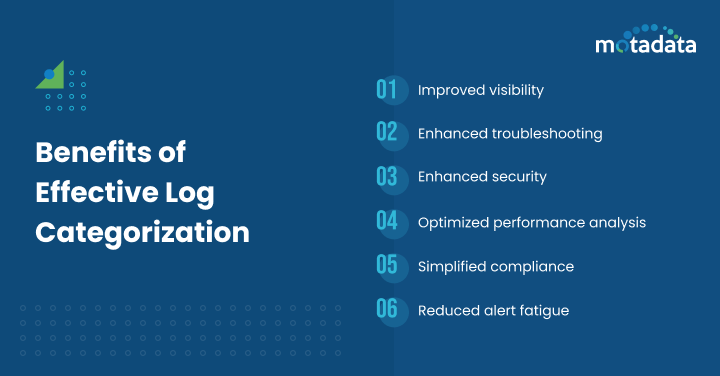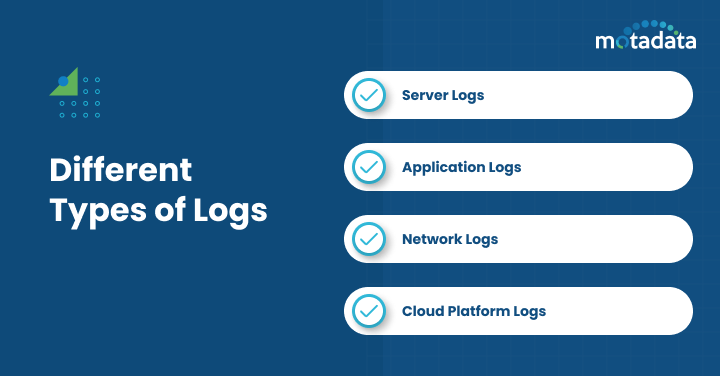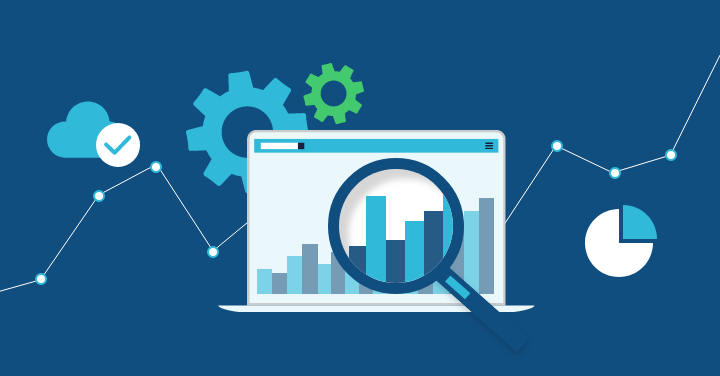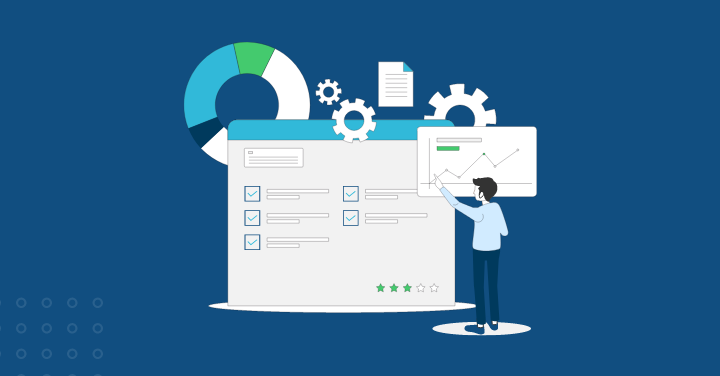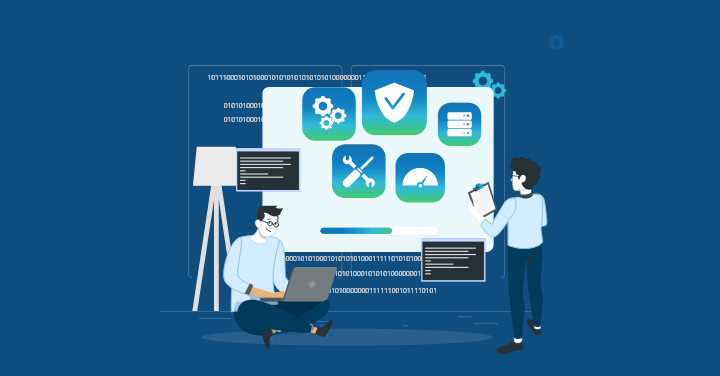Brief Overview of Log Management and its Importance
Log management is the process of collecting, storing, analyzing, and reporting on log data generated by IT systems.
Logs provide a valuable record of system activities, enabling organizations to:
- Troubleshoot issues: Identify the root causes of problems by analyzing log data.
- Monitor performance: Track system performance metrics and identify bottlenecks.
- Detect security threats: Identify unauthorized access or malicious activities.
- Comply with regulations: Ensure compliance with industry standards and regulations.
- Optimize resource utilization: Identify areas for improvement and resource allocation.
Effective log management is essential for maintaining a healthy and efficient IT infrastructure.
By leveraging log data, organizations can proactively address issues, improve performance, and enhance overall system reliability.
Challenges of uncategorized logs
Uncategorized logs, also known as “other” logs in Motadata AIOps, can significantly hinder effective log analysis and troubleshooting.
These logs are difficult to interpret and utilize due to the lack of associated metadata or context.
Key challenges of uncategorized logs:
- Limited visibility: Without categorization, it’s difficult to understand the source, type, or relevance of the logs.
- Difficulty in troubleshooting: Identifying the root cause of issues becomes challenging when logs cannot be correlated with specific devices or applications.
- Missed alerts: Critical events within uncategorized logs may not be detected or flagged for attention.
- Security risks: Unidentified logs can potentially contain sensitive information that may be exposed to unauthorized access.
To address these challenges, it’s crucial to assign appropriate log parsers to categorize incoming logs and extract meaningful information.
This enables efficient analysis, troubleshooting, and proactive management of IT infrastructure.
Benefits of Effective Log Categorization
Effective log categorization is essential for efficient log management and analysis. By organizing logs into meaningful categories, organizations can:
- Improved visibility: Easily identify and locate relevant logs based on categories.
- Enhanced troubleshooting: Correlate logs within categories to pinpoint root causes of issues.
- Enhanced security: Detect security threats more effectively by analyzing logs categorized as security-related.
- Optimized performance analysis: Analyze logs related to specific applications or devices to identify performance bottlenecks.
- Simplified compliance: Ensure compliance with regulations by organizing logs according to relevant categories.
- Reduced alert fatigue: Focus on critical events by filtering logs based on categories.
By implementing effective log categorization, organizations can significantly improve their ability to extract valuable insights from log data, troubleshoot issues efficiently, and maintain a healthy IT infrastructure.
Understanding Log Types
Different Types of Logs
Motadata AIOps supports a wide range of log types, covering various applications, devices, and systems. Here are some of the key log categories available:
Server Logs:
- Linux Syslog: Logs generated by Linux systems, providing information about system events, security, and application activity.
- Windows Event Logs: Logs generated by Windows systems, including Application, Security, and System logs.
- Apache Web Server Logs: Logs from Apache web servers, tracking access requests, errors, and performance metrics.
- Microsoft IIS Logs: Logs from Internet Information Services (IIS) web servers, recording requests, responses, and errors.
Application Logs:
- Database Logs: Logs from databases like MySQL, PostgreSQL, Oracle, and SQL Server, tracking queries, errors, and performance metrics.
- Web Application Logs: Logs from web applications, capturing user interactions, errors, and performance data.
- Middleware Logs: Logs from middleware components like application servers and message queues.
Network Logs:
- Firewall Logs: Logs from firewalls, recording network traffic, security events, and rule violations.
- Router Logs: Logs from routers, tracking routing updates, errors, and interface status.
- Switch Logs: Logs from switches, recording port status, MAC address table changes, and error messages.
Cloud Platform Logs:
- AWS Logs: Logs from various AWS services, including EC2, S3, RDS, and Lambda.
- Azure Logs: Logs from Azure services, such as VMs, storage, and application services.
Motadata AIOps also supports custom log parsing, allowing you to ingest and analyze logs from specific applications or devices not covered by built-in parsers.
This flexibility ensures comprehensive coverage of your log data.
Key Components of a Log
Logs typically contain structured data that can be parsed and analyzed to extract valuable information.
Common key components of a log include:
- Timestamp: The time and date when the log event occurred.
- Severity level: Indicates the importance of the log event (e.g., Error, Warning, Critical).
- Source: The device, application, or process that generated the log.
- Message: A textual description of the event, often including details about the error or action.
- Thread ID: The unique identifier for the thread or process that generated the log.
- Process ID (PID): The unique identifier for the process that generated the log.
- User ID: The user who triggered the event or action.
- Additional fields: Depending on the log type, there may be additional fields specific to the application or device generating the log.
These components provide essential context for understanding log events and correlating them with other data sources.
By extracting and analyzing these key fields, organizations can gain valuable insights into system behavior, identify issues, and troubleshoot problems effectively.
Importance of Standardized Log Formats
Standardized logs are crucial for effective log management and analysis.
They adhere to predefined formats and structures, ensuring consistency and interoperability across different systems and applications.
Key benefits of standardized logs:
- Enhanced analysis: Standardized logs are easier to parse, analyze, and correlate with other data sources.
- Improved troubleshooting: Consistent log formats facilitate efficient identification of root causes and problem resolution.
- Simplified integration: Standardized logs can be more easily integrated with various log management and analysis tools.
- Reduced complexity: Adhering to standards reduces the need for custom parsing and analysis techniques.
- Enhanced security: Standardized logs can help detect security threats more effectively by providing consistent data formats for analysis.
By adopting standardized log formats, organizations can streamline their log management processes, improve data quality, and gain valuable insights into their IT infrastructure.
Categorization Strategies
Log categorization is a fundamental aspect of effective log management, enabling organizations to organize and analyze log data efficiently.
Based on Log Type:
Application Logs
- Web Server Logs: Capture user requests, responses, and errors from web servers (e.g., Apache, IIS).
- Database Logs: Record database queries, errors, and performance metrics (e.g., MySQL, PostgreSQL).
- Application-Specific Logs: Capture events and data specific to individual applications (e.g., ERP, CRM, custom applications).
System Logs
- Operating System Logs: Record system events, errors, and performance metrics (e.g., Windows Event Logs, Linux syslog).
- Security Logs: Capture security-related events, such as authentication attempts, access controls, and intrusion detections.
- Network Logs: Record network traffic, connectivity issues, and device status (e.g., router, switch, firewall logs).
Infrastructure Logs
- Virtualization Logs: Capture events related to virtualization platforms (e.g., VMware, Hyper-V).
- Cloud Platform Logs: Record activities from cloud services (e.g., AWS, Azure, GCP).
- Storage Logs: Capture storage device events, performance metrics, and error messages.
By combining these categories, organizations can establish a comprehensive log categorization strategy that covers a wide range of IT components and facilitates efficient analysis and troubleshooting.
Based on Log Content:
By using keyword-based categorization or regular expression-based categorization, organizations can create highly customized and powerful rules for classifying logs.
Keyword-based categorization allows for straightforward classification based on specific terms or phrases within log messages.
This approach is effective for common scenarios like categorizing logs by application names, error messages, or security events.
Key benefits of keyword-based categorization:
- Enhanced searchability: Easily locate logs containing specific keywords or phrases.
- Improved analysis: Focus on logs related to specific events or errors.
- Automated categorization: Reduce manual effort by automatically classifying logs based on predefined patterns.
- Flexibility: Adapt categorization rules to evolving log formats and content.
Common keyword-based categorization examples:
- Error messages: Categorize logs based on specific error codes or messages.
- Application names: Group logs from different applications into separate categories.
- Device types: Categorize logs based on the device that generated them (e.g., servers, routers, firewalls).
- Security events: Identify security-related logs by searching for keywords like “unauthorized access,” “intrusion,” or “malware.”
- User actions: Categorize logs based on user actions or commands.
Regular expressions provide a more flexible and powerful approach for pattern matching and extraction.
They can handle complex patterns and variations in log formats, making them ideal for capturing specific data elements or identifying intricate patterns within log messages.
Key benefits of using regular expressions for log categorization:
- Flexibility: Regular expressions can handle complex patterns and variations in log formats.
- Precision: Accurately match and extract specific data elements from log messages.
- Customizability: Create custom regular expressions to match unique patterns in your log data.
- Automation: Automate the categorization process using regular expression-based rules.
Example regular expressions for log categorization:
- Extract IP addresses: \d{1,3}\.\d{1,3}\.\d{1,3}\.\d{1,3}
- Extract timestamps: \d{4}-\d{2}-\d{2} \d{2}:\d{2}:\d{2}
- Identify error messages: error|exception|failure
- Extract specific fields: (?<field1>\w+):\s*(?<field2>\w+)
Based on Log Severity:
Severity level is a crucial attribute of log messages, indicating the importance or impact of the event being logged.
Categorizing logs based on severity levels enables organizations to prioritize and focus on critical issues while filtering out less important information.
Common severity levels include:
- Critical: Critical alerts signal major network issues requiring immediate attention. These alerts indicate significant disruptions that can impact business operations. For instance, a critical alert might indicate a crucial application or service outage.
- Major: Major alerts signal potential network issues that require attention. These alerts indicate problems that could impact performance, security, or reliability. For instance, a major alert might indicate a device experiencing high resource usage.
- Warning: Warning alerts signal potential network issues that may impact future performance, security, or reliability. For instance, a warning might indicate low disk space on a device.
- Clear: Clear alerts indicate that network issues have been resolved. No further action is needed.
- Down: Down alerts signal service or device outages. These alerts indicate connectivity issues or device malfunction. When a device is in down state, Motadata AIOps is not able to monitor it. Proper alert severity configuration helps prioritize issues and ensure timely resolution.
By categorizing logs based on severity levels, organizations can prioritize their analysis and response efforts, focusing on critical issues while filtering out less important information.
This helps to improve efficiency and reduce alert fatigue.
Based on Log Source:
Categorizing logs based on their source provides valuable insights into the origin of events and facilitates efficient analysis and troubleshooting.
By understanding the source of a log, organizations can determine the specific system, application, or device responsible for generating the event.
Source-based log categories:
- Application Logs: Logs generated by specific applications, such as web servers, databases, or custom software.
- System Logs: Logs generated by operating systems, providing information about system events, errors, and performance.
- Infrastructure Logs: Logs from infrastructure components, including network devices, storage systems, and virtualization platforms.
- Security Logs: Logs related to security events, such as authentication attempts, access control, and intrusion detection.
- Device-Specific Logs: Logs generated by particular devices or hardware components.
By categorizing logs based on their source, organizations can:
- Focus on relevant logs: Identify logs related to specific applications or devices.
- Troubleshoot effectively: Pinpoint the root cause of issues by analyzing logs from the appropriate source.
- Improve performance analysis: Analyze logs from specific devices or applications to identify performance bottlenecks.
- Enhance security: Detect security threats by analyzing logs from relevant sources.
By implementing a well-defined log categorization strategy based on sources, organizations can gain a deeper understanding of their IT infrastructure and optimize their log management processes.
Implementing Log Categorization
By following these steps and leveraging the capabilities of a log management tool, organizations can effectively implement log categorization and gain valuable insights from their log data.
1. Choose a Log Management Tool:
Select a log management tool that supports log categorization and offers features like:
- Centralized logging: Collects logs from various sources.
- Log parsing: Extracts meaningful information from logs.
- Log categorization: Allows for flexible categorization options.
- Log analysis and visualization: Provides tools for analyzing and visualizing log data.
- Alerting and notification: Generates alerts for critical events.
2. Set Up Log Collection and Ingestion:
- Configure devices or applications to send logs to the log management tool.
- Use agents or forwarders to collect logs from various sources.
- Ensure proper network configuration for log transmission.
3. Create Custom Log Categories and Filters:
- Define custom categories based on your specific needs (e.g., application, system, security, infrastructure).
- Create filters to automatically classify logs into appropriate categories based on keywords, regular expressions, or other criteria.
4. Leverage Log Analytics for Insights:
Utilize the log management tool’s analytics capabilities to:
- Search and filter logs based on specific criteria.
- Correlate logs with other data sources.
- Identify trends and anomalies.
- Generate reports and visualizations.
Additional Considerations:
- Data Retention: Define retention policies for log data to comply with regulations and optimize storage.
- Security: Implement security measures to protect log data from unauthorized access.
- Integration: Integrate the log management tool with other IT systems for a holistic view of your environment.
- Training and Support: Provide training to users and have a support team available for assistance.
Motadata AIOps offers a comprehensive log management solution that simplifies the process of collecting, analyzing, and visualizing log data.
With its advanced features and user-friendly interface, Motadata AIOps empowers organizations to:
- Centralize Log Management: Collect logs from various sources and consolidate them into a single platform.
- Leverage Powerful Analytics: Utilize advanced analytics to extract valuable insights from log data, including anomaly detection, correlation, and root cause analysis.
- Create Customized Dashboards: Visualize log data in real-time to monitor system performance, identify trends, and detect issues proactively.
- Integrate with other tools: Seamlessly integrate with other IT management tools for a holistic view of your environment.
- Ensure Compliance: Meet industry regulations and standards by effectively managing and analyzing log data.
By choosing Motadata AIOps, organizations can optimize their log management processes, improve network visibility, and make data-driven decisions to enhance their IT operations.
Best Practices for Log Categorization
1. Regular Review and Refinement
- Periodically review your log categorization strategy to ensure it remains aligned with your organization’s evolving needs and objectives.
- Identify areas for improvement and make necessary adjustments to the categorization rules.
- Consider adding or removing categories as your IT environment changes.
2. Balancing Granularity and Manageability
- Strike a balance between granular categorization (e.g., specific application modules) and manageable categories to avoid excessive complexity.
- Consider the level of detail required for your analysis and reporting needs.
- Avoid creating overly granular categories that may become difficult to manage and analyze.
3. Considering Security and Compliance Requirements
- Ensure that your log categorization strategy aligns with relevant security and compliance regulations.
- Identify the specific log categories required for compliance and audit purposes.
- Implement appropriate controls to protect sensitive information within log data.
4. Using Log Categorization for Incident Response and Troubleshooting
- Leverage categorized logs to quickly identify relevant information during incident response investigations.
- Correlate logs within categories to pinpoint root causes and resolve issues efficiently.
- Use log categorization to prioritize incidents based on severity and impact.
By following these best practices, organizations can optimize their log categorization strategies, improve the efficiency of log management, and gain valuable insights into their IT infrastructure.
Conclusion
Effective log categorization is a cornerstone of efficient log management, providing numerous benefits for organizations.
By organizing logs into meaningful categories, organizations can:
- Improve searchability and analysis: Easily locate and analyze relevant logs.
- Enhance troubleshooting: Identify root causes of issues and resolve them efficiently.
- Optimize performance: Analyze logs to identify performance bottlenecks and optimize resource utilization.
- Strengthen security: Detect and respond to security threats proactively.
- Ensure compliance: Adhere to industry regulations and standards.
Implementing a well-defined log categorization strategy requires careful consideration of factors such as log volume, analysis requirements, and integration with other systems.
By following best practices and leveraging advanced log management tools like Motadata AIOps, organizations can maximize the value of their log data and optimize their IT operations.
FAQs:
Log categorization is essential for effective log management. By categorizing logs based on their type, you can gain valuable insights into your IT infrastructure.
Key log types include:
- Application Logs: Web server, database, custom application logs.
- System Logs: Operating system, security, and network logs.
- Infrastructure Logs: Virtualization, cloud platform, storage logs.
Categorizing logs based on these types helps you identify relevant logs, troubleshoot issues, analyze performance, and enhance security.
To align log categorization with compliance and security requirements:
- Identify relevant regulations.
- Define compliance requirements.
- Map requirements to log categories.
- Implement appropriate categorization strategies.
- Review and update regularly.
- Implement data retention policies.
- Conduct regular audits.
By following these steps, organizations can ensure their log management practices meet compliance standards and mitigate risks.
Log categorization enhances security monitoring by:
- Identifying suspicious activity.
- Detecting unauthorized access.
- Monitoring network traffic.
- Analyzing security alerts.
- Investigating security breaches.
- Complying with regulations.
By categorizing logs effectively, organizations can strengthen their security posture and protect sensitive information.



